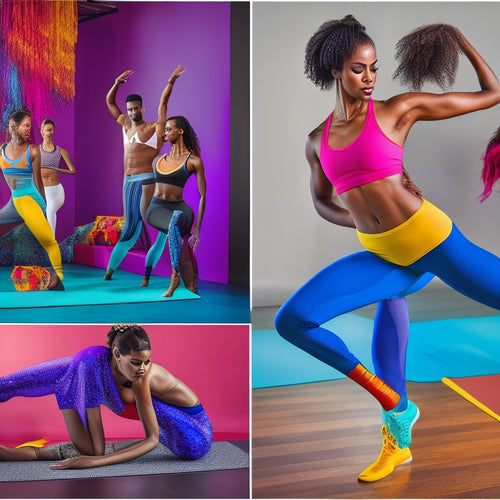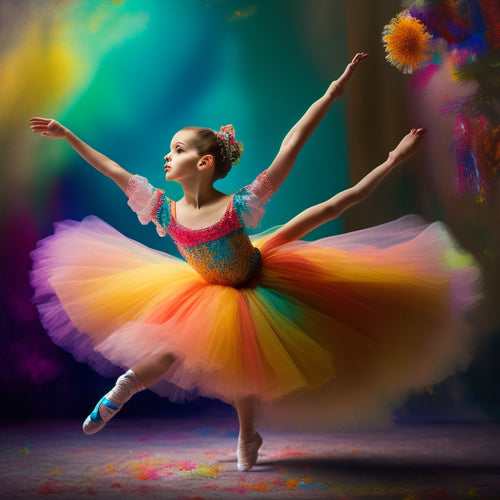
10 Essential Digital Makeup Guides for Beginners
Share
You're about to immerse yourself in the world of digital makeup, where creativity knows no bounds and flawless skin is just a brush stroke away. As a beginner, you'll want to start with the essentials: mastering digital brush strokes, creating realistic skin tones, and understanding color theory. Next, explore essential digital tools like Adobe Photoshop and Wacom Tablets. Build a stunning portfolio that showcases your skills and style. Then, delve into contouring, highlighting, and accentuating facial features. Finally, learn to transform inspiration into digital art. As you explore these guides, you'll discover the secrets to creating breathtaking digital makeup looks that will leave everyone mesmerized.
Key Takeaways
• Mastering digital makeup brush strokes is crucial for achieving a natural, realistic look in digital art.
• Understanding skin undertones and using a color picker tool helps create realistic skin tones digitally.
• Accentuating facial features through facial mapping, contouring, and highlighting enhances digital makeup looks.
• A soft, peach-toned highlighter and seamless blending are key to achieving a natural-looking glow in digital makeup.
• Practicing with essential digital tools like Adobe Photoshop and Wacom Tablet helps beginners develop their digital makeup skills.
Mastering Digital Makeup Brush Strokes
Mastering digital makeup brush strokes requires honing your skills in manipulating digital tools to mimic the subtle nuances of real-life makeup application. As you immerse yourself in the world of digital makeup, it's crucial to understand that creating realistic looks depends heavily on your ability to control your digital brushes.
You'll need to develop a Digital Flow that feels natural and intuitive, just like applying makeup in real life. To achieve this, focus on Brush Control - the way you move your digital brushes, the pressure, and the strokes.
Practice holding your digital brush at different angles, applying varying levels of pressure, and experimenting with different stroke lengths. This will help you achieve the subtle nuances and blending that make digital makeup look realistic.
Creating Realistic Skin Tones Digitally
As you've honed your digital brush skills, it's time to focus on the foundation of any digital makeup look: creating realistic skin tones that capture the subtle variations and nuances of human skin. To achieve this, it's important to understand skin undertones, which can be warm, cool, or neutral. Warm undertones have a yellow or golden base, while cool undertones have a pink or blue base. Neutral undertones are a mix of both.
When creating realistic skin tones digitally, it's vital to match the tone of your subject's skin. Study the skin tones of your subject and identify the undertones. Then, use a color picker tool to select the exact shade. Don't be afraid to experiment and adjust the tone to achieve a natural look.
Essential Tools for Digital Artists
With a solid grasp of digital makeup techniques, you're now ready to explore the essential tools that will take your digital artistry to the next level. Having the right digital workspaces and artistic software can make all the difference in creating stunning digital makeup looks.
Here are some must-have tools to elevate your digital artistry:
| Tool | Description | Cost |
|---|---|---|
| Adobe Photoshop | Industry-standard image editing software | $20.99/month |
| Sketchbook Pro | Digital painting and drawing software | $19.99/month |
| Wacom Tablet | High-precision drawing tablet | $69.95 - $499.95 |
| Clip Studio Paint | Comic and manga creation software | $299.99 (one-time purchase) |
| Autodesk Sketchbook | Drawing and painting software | Free (basic), $29.99/month (pro) |
These tools will help you create realistic skin tones, experiment with different makeup looks, and refine your digital artistry skills. Remember, practice makes perfect, so be sure to experiment with each tool to find what works best for you.
Building a Digital Makeup Portfolio
Now that you've got the essential tools under your belt, it's time to build a digital makeup portfolio that showcases your skills and creativity. This is where you get to demonstrate your expertise and style, and it's an important step in establishing your digital presence.
Think of your portfolio as a visual resume, highlighting your best work and showcasing your range as a digital makeup artist. When building your portfolio, consider the type of clients you want to attract and tailor your work accordingly.
A strong online branding strategy is key to attracting the right clients, so make sure your portfolio is cohesive and reflects your unique style.
Understanding Color Theory in Digital Art
You'll need to master the fundamentals of color theory to take your digital makeup art to the next level, as a deep understanding of color relationships and harmony is what sets apart amateurish attempts from professional-grade work.
When it comes to creating stunning digital makeup looks, color harmony is key. You want your digital palettes to pop, not clash. To achieve this, you'll need to grasp the basics of color theory, including the color wheel, primary and secondary colors, warm and cool tones, and monochromatic, analogous, and complementary color schemes.
Understanding how to create harmonious color combinations will elevate your digital makeup art, making it more visually appealing and engaging. You'll be able to craft cohesive, professional-looking designs that showcase your skills and creativity.
Digital Makeup for Different Skin Types
Tap into the nuances of digital makeup by considering the unique characteristics of various skin types. Each skin type demands a distinct approach to create a flawless, realistic finish. You'll need to take into account skin undertones, which can be warm, cool, or neutral.
Warm skin undertones look great with golden, yellow-based hues, while cool skin undertones are enhanced by pink, blue-based shades. Neutral skin undertones can pull off a wide range of colors.
When working with digital makeup, you have endless customization options at your fingertips. You can experiment with different foundation shades, concealer tones, and powder finishes to find the perfect match for your subject's skin type.
For oily skin, you may want to use a matte finish to reduce shine, while dry skin may benefit from a hydrating, dewy look. By understanding the specific needs of each skin type, you can create a digital makeup look that's tailored to perfection.
With practice and patience, you'll be able to create stunning, realistic digital makeup looks that make your subjects feel confident and beautiful.
From Sketch to Digital Reality
With a clear understanding of skin types and tone in mind, you can begin initiating your digital makeup vision to life by translating your sketch into a realistic, digitally rendered look. This is where the magic happens, and your creativity knows no bounds. You're about to start on a digital evolution, where your artistic freedom takes center stage.
As you start constructing your digital look, remember that the key to success lies in the details. Pay attention to the subtleties of light and shadow, texture, and color. These elements will make or break the realism of your final result. Don't be afraid to experiment and try new things – after all, that's what digital makeup is all about.
With each brush stroke, you're one step closer to revealing your full artistic potential. So, take a deep breath, let your imagination run wild, and watch as your sketch transforms into a stunning digital reality. The possibilities are endless, and the best part? You're in complete control.
Digital Contouring and Highlighting
As you start experimenting with digital contouring and highlighting, you'll quickly realize that it's all about enhancing your natural features without looking overdone.
You'll learn how to strategically place shadows to create definition, accentuate your facial features, and apply highlights that look like they're coming from within.
Mastering Shadow Placement
You'll achieve a more defined, sculpted look by strategically placing shadows on your digital canvas, which is essential for creating a natural-looking contour. When it comes to mastering shadow placement, understanding Face Geometry is key. This involves identifying the areas of your face where shadows naturally fall, such as the hollows of your cheeks and the crevices around your eyes.
To enhance Eye Dimension, focus on creating subtle shadows in the creases of your eyelids and under your eyebrows. This will add depth and dimension to your eyes. For a more natural look, blend your shadows seamlessly into the surrounding skin tone.
Here's a breakdown of where to place your shadows:
| Area | Shadow Placement |
|---|---|
| Cheekbones | Hollows of the cheeks |
| Eyes | Creases of the eyelids, under the eyebrows |
| Nose | Sides of the nose bridge |
| Jawline | Along the jawbone |
Accentuating Facial Features
Now that you've mastered shadow placement, it's time to take your digital makeup skills to the next level by accentuating your facial features through strategic contouring and highlighting. This is where the magic happens, and your digital makeup look starts to come alive!
When it comes to accentuating your facial features, it's all about creating the illusion of defined cheekbones, a slimmer nose, and a more radiant complexion. By using digital contouring and highlighting techniques, you can create a more symmetrical and balanced look.
Here are some essential tips to keep in mind:
-
Facial Mapping: Understand the anatomy of your face and identify areas that need contouring and highlighting.
-
Feature Framing: Use contouring to create the illusion of defined features, such as a smaller nose or more prominent cheekbones.
-
Blend, blend, blend!: Seamless blending is key to creating a natural-looking contour and highlight.
Natural-Looking Highlight
With your facial features mapped and contoured, it's time to add the finishing touches with a natural-looking highlight that will make your digital makeup look truly radiant. Highlight placement is key to achieving an everyday glow that enhances your features without looking too done-up.
To get started, identify the high points of your face - the tops of your cheekbones, nose, and cupid's bow. These areas naturally catch the light, so it's essential to emphasize them with a subtle highlight.
Using a digital makeup tool, apply a soft, peach-toned highlighter to these areas, blending seamlessly into the surrounding skin. Remember, the goal is a natural-looking glow, not a flashy spotlight. Start with a light hand and build up gradually, as it's easier to add more highlight than it's to remove excess.
Enhancing Facial Features Digitally
Now that you've mastered digital contouring and highlighting, it's time to focus on enhancing your facial features digitally.
You'll learn how to define your facial structure, use natural contouring techniques to create a flawless base, and accentuate your key features to make your digital makeup look truly pop.
Defining Facial Structure
As you explore the world of digital makeup, identifying your facial structure is essential to enhancing your features and creating a flawless base for your virtual looks. Understanding your facial shape, bone structure, and facial mapping will help you accentuate your best features and hide imperfections.
To define your facial structure, start by:
- Identifying your face shape: oval, round, square, heart-shaped, or diamond
- Analyzing your bone structure: high cheekbones, prominent jawline, or delicate features
- Mapping your facial features: location of your eyebrows, shape of your eyes, and contour of your nose
Knowing your facial structure will help you choose the right digital makeup looks, from highlighting and contouring to enhancing your natural features. It's the foundation of creating a stunning virtual look that's tailored to your unique features.
Natural Contouring Techniques
Mastering natural contouring techniques that enhance your facial features in a way that looks and feels authentic requires understanding where to apply contour and highlight.
Debunking common contouring myths, like the idea that contouring is only for certain face shapes or skin types, is crucial. Anyone can benefit from contouring, regardless of their features or skin tone.
Start by identifying the areas of your face where you want to create definition, such as the hollows of your cheeks, the sides of your nose, and your jawline. Using a digital makeup tool, subtly apply contour shades to these areas, blending seamlessly into the surrounding skin.
Accentuating Key Features
To take your digital makeup skills to the next level, focus on accentuating your key facial features, like your eyes, brows, and lips, which can instantly elevate your entire look and create a more polished, put-together appearance. By enhancing these features, you'll create a harmonious balance that showcases your unique Facial Geometry. This balance is key to a flawless digital makeup look.
Here are some tips to get you started:
-
Highlight your brow bone: Adding a subtle highlight to your brow bone can lift your entire face and make your eyes appear larger.
-
Define your lip shape: Use digital makeup tools to enhance your natural lip shape, creating a more defined and luscious pout.
-
Make your eyes pop: Accentuate your eyes by adding depth and dimension with digital eyeshadows, liners, and lashes.
Turning Inspiration Into Digital Art
Tap into your creative vision by collecting reference images, scribbling rough sketches, or jotting down descriptive words that evoke the look and feel you want to achieve in your digital art. This is where your inspiration boards come in – a visual representation of your creative freedom. Pin up images, colors, and textures that evoke the mood and atmosphere you want to convey. Don't worry too much about why something catches your eye; just trust your instincts and let your inspiration board evolve.
As you gather more references, you'll start to notice patterns and themes emerging. This is where your creative vision starts to take shape. You might realize you're drawn to bold, bright colors or soft, pastel hues. Maybe you're inspired by nature, architecture, or abstract patterns. Whatever it is, let it guide you as you start creating your digital art.
Frequently Asked Questions
Can I Use a Mouse Instead of a Graphics Tablet for Digital Makeup?
"Honey, let's get real, using a mouse for digital makeup is like trying to paint a masterpiece with a crayon. While it's doable, you'll lack the precision and control of a graphics tablet, making it a less-than-ideal alternative."
How Do I Achieve Realistic Eyelashes in Digital Art?
"When creating realistic eyelashes, you'll want to experiment with lash textures and consider the eye shape you're working with - almond, round, or hooded - to achieve a natural, fluttering effect in your digital art."
Are Digital Makeup Tutorials Only for Beauty Professionals?
'Just like a painter needs a canvas, you need digital makeup tutorials to harness your creative potential. No, they're not just for beauty pros - they're for anyone seeking industry standards and creative freedom to enhance their digital art skills.'
Can I Sell My Digital Makeup Art as Commercial Work?
"You can sell your digital makeup art commercially, but consider licensing options carefully and develop smart pricing strategies to maximize your earnings; research popular marketplaces and platforms to showcase your art."
Do I Need to Know How to Draw to Learn Digital Makeup?
"Ha! Think you need to be a Picasso to master digital makeup? Not quite. While an artistic background can be helpful, it's not a prerequisite. You'll still have creative freedom to experiment and learn, and that's what matters."
Related Posts
-

What Contemporary Dancewear Essentials Do Dancers Need
As a contemporary dancer, you need essentials that enhance your flexibility and creativity. Opt for high-waisted legg...
-

Artistic Fusion: Lerma's Little Dancer Triumphs
As I reflect on my artistic journey, I'm struck by the profound evolution that has occurred, marked by the triumphant...
-

Frozen Frenzy: Creative Crafts Galore
We're entering a winter wonderland of creativity, where snowflakes sparkle, ice castles shine, and magic unfolds in e...


